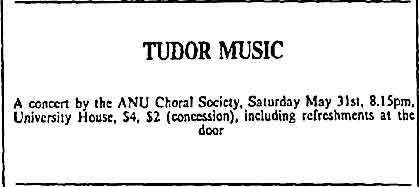

SCUNA history » Concerts » 1980 - May
On this page: Advertisement | Publicity | Poster | Programme | Review | Acknowledgement

A concert by the ANU Choral Society, Saturday May 31st, 8.15pm, University House, $4, $2 (concession), including refreshments at the door.
Source: Advertising. (1980, May 28). The Canberra Times (ACT : 1926 - 1995), p. 32. Retrieved May 17, 2013, from Trove: http://nla.gov.au/nla.news-article110959635

THE WORLD OF MUSIC By W. L. HOFFMANN
Two attractive but very different programs of unaccompanied choral music are being presented in Canberra tonight and tomorrow night. At the School of Music today at 5.30pm, as the third of this year's Twilight Recital Series being offered by the school, there will be a program of 'Choral Music since 1800'. Composers represented range from Beethoven and Brahms, through Britten, Vaughan Williams and Stravinsky, to the contemporary Americans, Barber and Persichetti.
Most of the works to be sung are short, but quite representative of the individual composers: the longest is the 'Marienlieder' of Brahms. He was one of the few major composers since 1800 to make a significant contribution to the repertoire of unaccompanied choral music, and his 'Marienlieder' of 1860 is a setting of seven verses of unknown origin relating to the Virgin Mary.
Another work on a religious basis will be the 'Pater Noster' of Stravinsky, one of three short liturgical choruses, originally written in 1926 and later revised.
All the remaining works of the program arc secular, poetic in content, except only for Beethoven who is to be represented by one of his jocular canons 'Ta, ta, ta, ta', which he wrote in 1812 to express his pleasure with the metronome, then a newly invented device.
This interesting program is to be sung by the School of Music Chamber Choir of 23 voices, under the direction of Warren Bebbington.
Tomorrow night's program is by the ANU Choral Society, which will sing a 'Concert of Tudor Music' in the Hall of University House beginning at 8.15. [Emphasis mine. -Val]
Directed by Keith Radford, the choir will present English choral music from the late 16th and early 17th centuries; all the composers represented in the program held appointments in the Chapel Royal during that period. Thomas Morley, Thomas Tomkins and Orlando Gibbons all contributed greatly to the development of polyphonic choral music in England, and works by them make up the first half of the program.
However, the major work of the concert is to be the 'Mass for five voices' by William Byrd, one of the three Masses which he wrote. All four composers were contemporaries (indeed, Morley and Byrd died in the same year, 1603, Gibbons died two years later) and this program offers the opportunity to compare, side by side, their individual approaches to music for voices.
Also tomorrow night, the Canberra Youth Orchestra Society's "other groups" will give their own concert in the School of Music, beginning at 7.30. Five junior ensembles - the Symphonic Band, thc String Group, and the Wind Ensemble, together with the Intermediate Orchestra and the James McCusker Orchestra - will each play a short program, giving the players concert experience, and displaying to the community the musical strength of young instrumentalists in Canberra.
Many of those playing tomorrow night will eventually take their place in the senior Canberra Youth Orchestra, and they deserve the interest and support of the community, for in their development lies the future of instrumental music in Canberra.
Source: THE WORLD OF MUSIC Unaccompanied choral programs. (1980, May 30). The Canberra Times (ACT : 1926 - 1995), p. 6. Retrieved March 8, 2014, from http://nla.gov.au/nla.news-article110959961
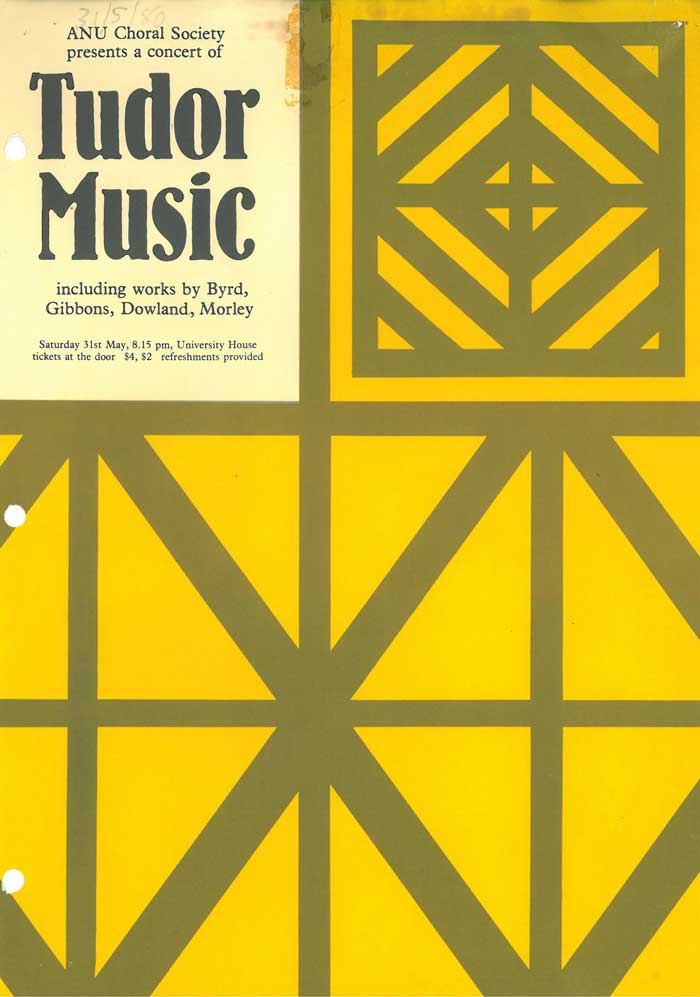
ANU Choral Society
presents a concert of
Tudor Music
including works by Byrd, Gibbons, Dowland, Morley
Saturday 31st May, 8.15 pm, University House
tickets at the door $4, $2 refreshments provided
I have not seen the original poster. It was probably A4 in size, and looks to have been designed by ANU Visual Arts.
The poster is yellow ("golden") and appears to represent an English half-timbered house, appropriate for the Tudor period. All the text is confined to a "window" in the top left of the page.
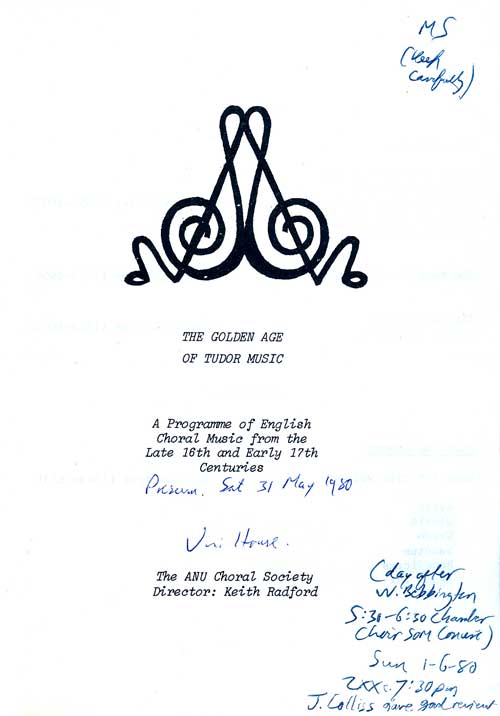
[Annotation: MS (Keep carefully)]
[Top half of SCUNA logo]
THE GOLDEN AGE OF TUDOR MUSIC
A Programme of English Choral Choral Music from the Late 16th and Early 17th Centuries
[Annotation: Presum. Sat 31 May 1980
Uni House.]
The ANU Choral Society
Director: Keith Radford
[Annotation: (day after
W. Bebbington 5:30 - 6:30 Chamber
Choir SOM Concert)
Sun 1-6-80
2XX 7:30pm
J. Collis gave good review
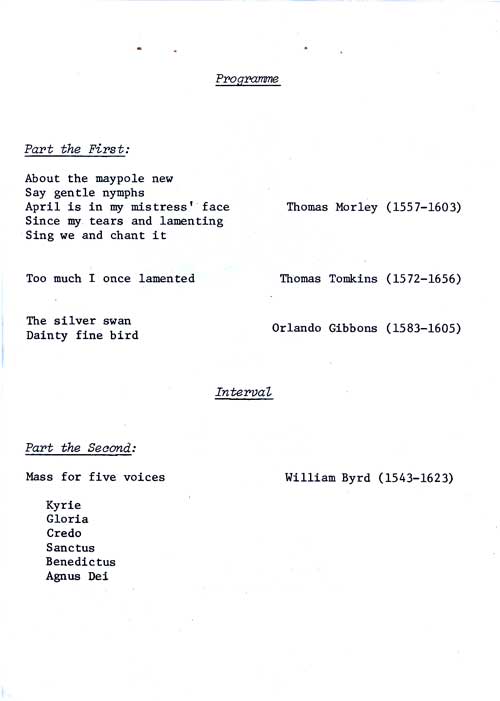
| Programme | |
| Part the First: | |
| About the maypole new Say gentle nymphs April is in my mistress' face Since my tears and lamenting Sing we and chant it |
Thomas Morley (1557-1603) |
| Too much I once lamented | Thomas Tomkins (1572-1656) |
| The silver swan Dainty fine bird |
Orlando Gibbons (1583-1605) |
| Interval | |
| Part the Second: | |
| Mass for five voices | William Byrd (1543-1623) |
| Kyrie | |
| Gloria | |
| Credo | |
| Sanctus | |
| Benedictus | |
| Agnus Dei | |
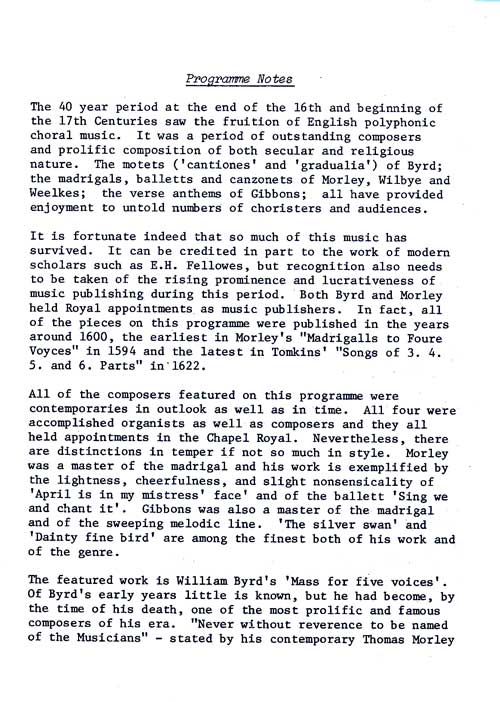
Programme Notes
The 40 year period at the end of the 16th and beginning of the 17th Centuries saw the fruition of English polyphonic choral music. It was a period of outstanding composers and prolific composition of both secular and religious nature. The motets ('cantiones' and 'gradualia') of Byrd; the madrigals, balletts and canzonets of Morley, Wilbye and Weelkes; the verse anthems of Gibbons; all have provided enjoyment to untold numbers of choristers and audiences.
It is fortunate indeed that so much of this music has survived. It can be credited in part to the work of modern scholars such as E.H. Fellowes, but recognition also needs to be taken of the rising prominence and lucrativeness of music publishing during this period. Both Byrd and Morley held royal appointments as music publishers. In fact, all of the piece on this programme were published in the years around 1600, the earliest in Morley's "Madrigalls to Foure Voyces" in 1594 and the latest in Tomkins' "Songs of 3. 4. 5. and 6. Parts" in 1622.
All of the composers featured on this programme were contemporaries in outlook as well as in time. All four were accomplished organists as well as composers and they all held appointments in the Chapel Royal. Nevertheless, there are distinctions in temper if not so much in style. Morley was a master of the madrigal and his work is exemplified by the lightness, cheerfulness, and slight nonsensicality of 'April is in my mistress' face' and of the ballett 'Sing we and chant it'. Gibbons was also a master of the madrigal and of the sweeping melodic line. 'The silver swan' and 'Dainty fine bird' are among the finest both of his work and of the genre.
The featured work is William Byrd's 'Mass for five voices'. Of Byrd's early years little is known, but he had become, by the time of his death, one of the most prolific and famous composers of his era. "Never without reverence to be named of the Musicians" - stated by his contemporary Thomas Morley [continued]
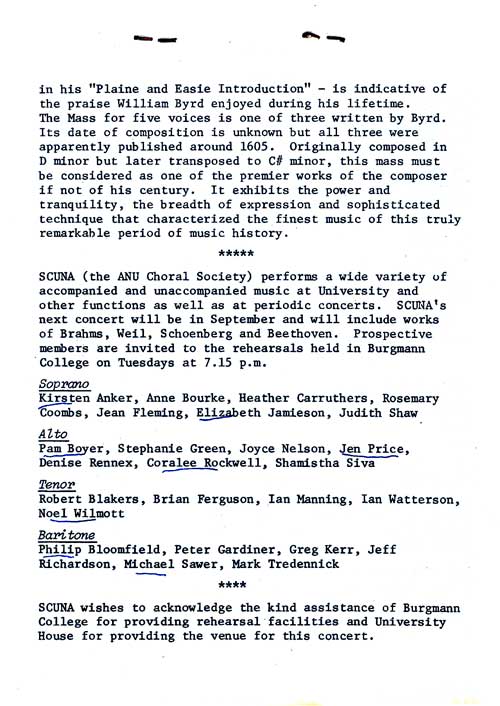
in his "Plaine and Easie Introduction" - is indicative of the praise William Byrd enjoyed during his lifetime. The Mass for five voices is one of three written by Byrd. Its date of composition is unknown but all three were apparently published around 1605. Originally composed in D minor but later transposed to C# minor, this mass must be considered as one of the premier works of the composer if not of his century. It exhibits the power and tranquility, the breadth of expression and sophisticated technique that characterized the finest music of this truly remarkable period of music history.
*****
SCUNA (the ANU Choral Society) performs a wide variety of accompanied and unaccompanied music at University and other functions as well as at periodic concerts. SCUNA's next concert will be in September and will include works of Brahms, Weil, Schoenberg and Beethoven. Prospective members are invited to the rehearsals held in Burgmann College on Tuesdays at 7.15 p.m.
Soprano
Kirsten Anker, Anne Bourke, Heather Carruthers, Rosemary Coombs, Jean Fleming, Elizabeth Jamieson, Judith Shaw
Alto
Pam Boyer, Stephanie Green, Joyce Nelson, Jen Price, Denise Rennex, Coralee [sic] Rockwell, Shamistha Siva
Tenor
Robert Blakers, Brian Ferguson, Ian Manning, Ian Watterson, Noel Wilmott
Baritone
Philip Bloomfield, Peter Gardiner, Greg Kerr, Jeff Richardson, Michael Sawer, Mark Tredennick
*****
SCUNA wishes to acknowledge the kind assistance of Burgmann College for providing rehearsal facilities and University House for providing the venue for this concert.
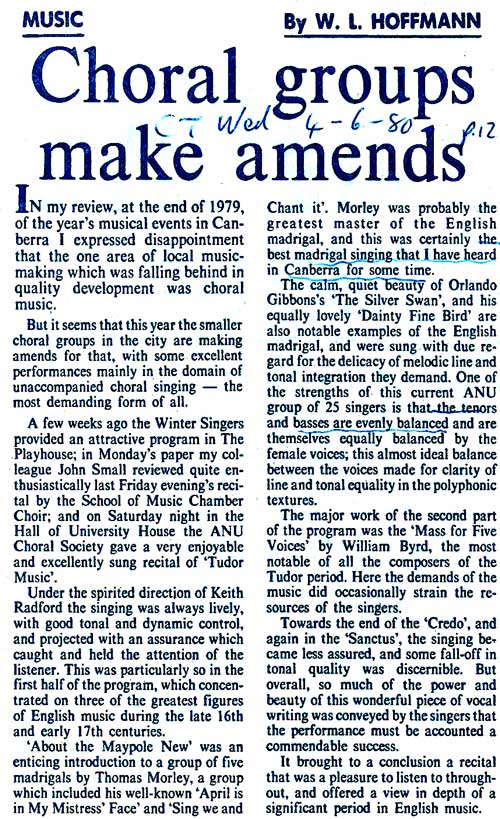
MUSIC By W.L. HOFFMANN
[Handwritten: CT Wed 4-6-80 p.12]
In my review, at the end of 1979, of the year's musical events in Canberra I expressed disappointment that the one area of local music-making which was falling behind in quality development was choral music.
But it seems that this year the smaller choral groups in the city are making amends for that, with some excellent performances mainly in the domain of unaccompanied choral singing - the most demanding form of all.
A few weeks ago the Winter Singers provided an attractive program in The Playhouse; in Monday's paper my colleague John Small reviewed quite enthusiastically last Friday evening's recital by the School of Music Chamber Choir; and on Saturday night in the Hall of University House the ANU Choral Society gave a very enjoyable and excellently sung recital of 'Tudor Music'.
Under the spirited direction of Keith Radford the singing was always lively, with good tonal and dynamic control, and projected with an assurance which caught and held the attention of the listener. This was particularly so in the first half of the program, which concentrated on three of the greatest figures of English music during the late 16th and early 17th centuries.
'About the Maypole New' was an enticing introduction to a group of five madrigals by Thomas Morley, a group which included his well-known 'April is in My Mistress' Face' and 'Sing we and Chant it'. Morley was probably the greatest master of the English madrigal, and this was certainly the best madrigal singing that I have heard in Canberra for some time.
The calm, quiet beauty of Orlando Gibbons's 'The Silver Swan', and his equally lovely 'Dainty Fine Bird' are also notable examples of the English madrigal, and were sung with due regard for the delicacy of melodic line and tonal integration they demand. One of the strengths of this current ANU group of 25 singers is that the tenors and basses are evenly balanced and are themselves equally balanced by the female voices; this almost ideal balance between the voices made for clarity of line and tonal equality in the polyphonic textures.
The major work of the second part of the program was the 'Mass for Five Voices' by William Byrd, the most notable of all the composers of the Tudor period. Here the demands of the music did occasionally strain the resources of the singers.
Towards the end of the 'Credo', and again in the 'Sanctus', the singing became less assured, and some fall-off in tonal quality was discernible. But overall, so much of the power and beauty of this wonderful piece of vocal writing was conveyed by the singers that the performance must be accounted a commendable success.
It brought to a conclusion a recital that was a pleasure to listen to throughout, and offered a view in depth of a significant period in English music.
Thanks to Maggie Shapley, ANU Archivist, for providing scans of SCUNA material held in the ANU Archives. Thanks also to Dr Michael Sawer, the original owner of the documents represented above.